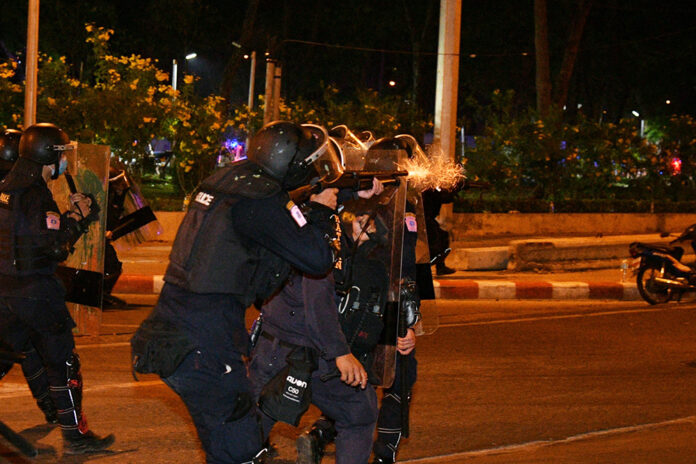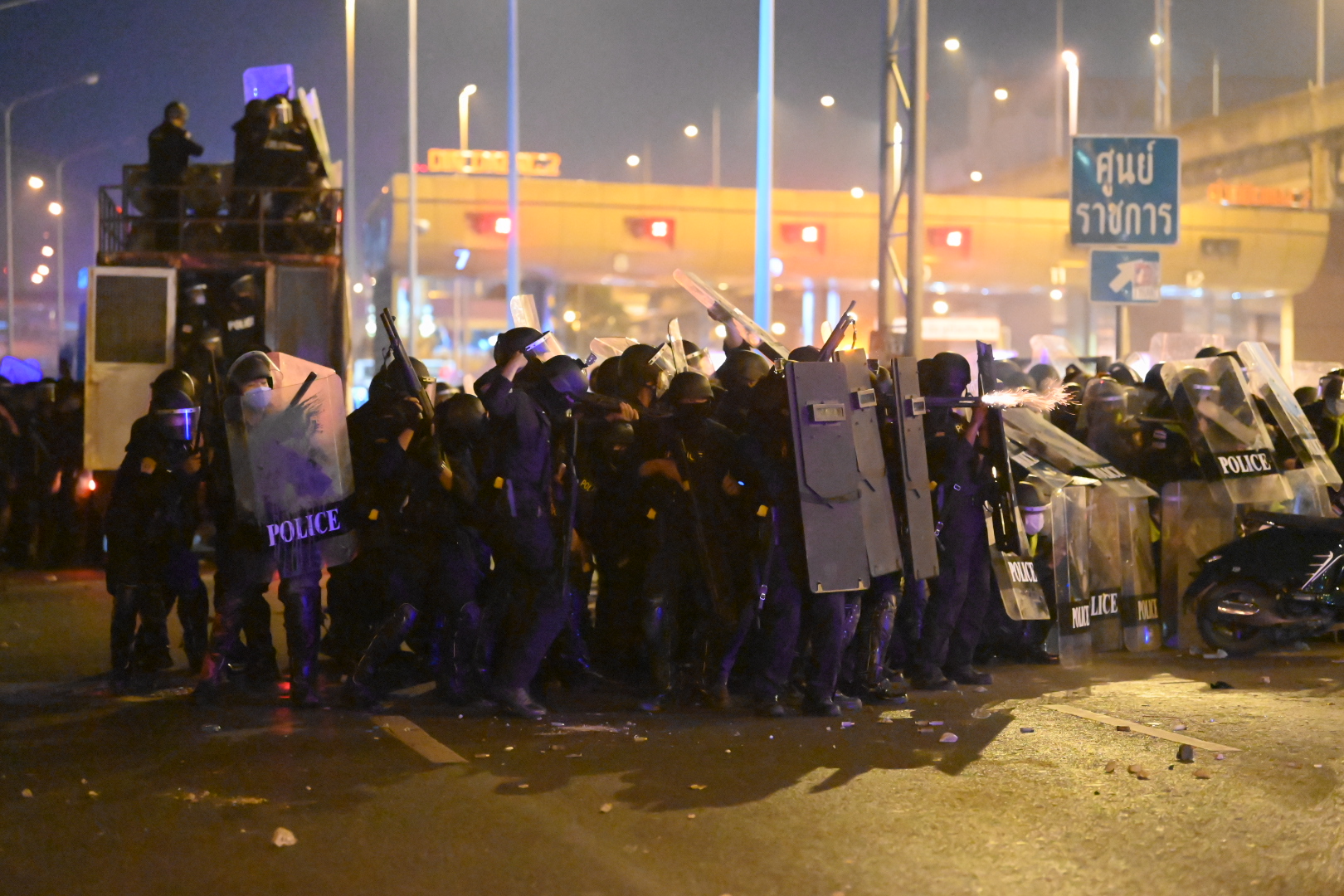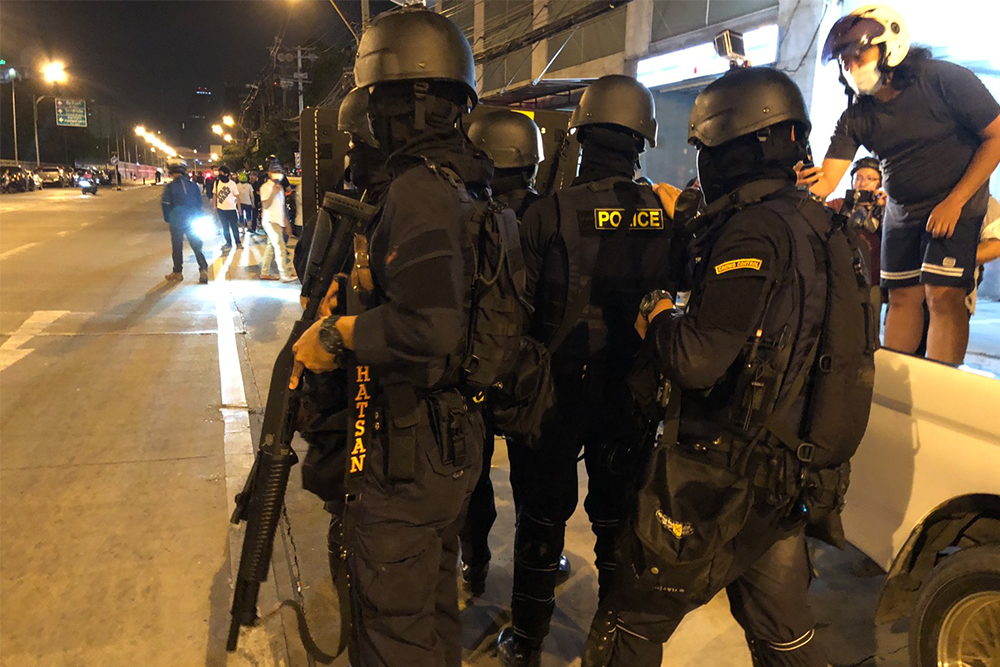
BANGKOK — Human rights groups on Tuesday said the riot police’s use of rubber baton rounds during Sunday’s crackdown on protesters was disproportionate.
The crackdown in front of the 1st Infantry Regiment base, where PM Prayut Chan-o-cha has his residence, marked the first known case of police firing the rounds at demonstrators since the street protests began in early 2020.
Police officials defended the tactic, but a peace advocate said it was an excessive use of force against the protesters, who were unarmed about to leave the area without much resistance.
Read: Activists Weigh on ‘Leaderless’ Protest Tactic After Night of Chaos
“The police overstepped their authority,” said Eakpant Pindavanija, the director of Mahidol University’s Institute of Human Rights and Peace Studies. “The protesters were about to leave, but the police resorted to use water cannons, tear gas, and rubber bullets against them and prevented them from leaving.”
Non violence advocate Angkhana Neelapaijit, who used to serve in the National Human Rights Commission, said the police did not follow the international guidance on the use of rubber baton rounds on Sunday.
She said many photos from the clashes show several demonstrators being hit by the bullets on the upper parts of their bodies.
“If it hits important parts of the body, it can cause serious injury or permanent disability,” Angkhana said.

She went on, “I have seen photos of protesters being hit at their abdomen and arms, which isn’t right since the United Nations’ guidance specifies that the weapon must be aimed at lower parts of the body. They must be fired at specific targets, especially those who carry weapons. But the police just fired indiscriminately.”
Although marketed as a less lethal alternative to live rounds, a rubber bullet is in essence a metal shell coated in rubber or other non-penetrating materials, which can still cause injuries upon impacts.
In 2010, a Redshirt protester named Santipong Injan lost some of his eyesight after he was struck in the right eye with a rubber bullet during a military crackdown at Khok Wua Intersection.
Demonstrators on Sunday marched from Victory Monument to the infantry base about 2.5 kilometers away to protest against PM Prayut’s stay at taxpayer-funded residence inside the installation. They also dismantled obstacles laid out by police around the base and a brief confrontation ensued.

About half an hour later, protesters retreated to the front of the Veterans General Hospital after rumors were spreading that riot police were preparing a crackdown. They began hurling objects they could find at riot police, to which police retaliated with water cannons, tear gas, and finally rubber bullets.
Khaosod English correspondents at the scene said police appeared to rely more on the rubber metal rounds than any other crowd control measures on Sunday night. When another clash flared up in front of Din Daeng Police Station later that night, the bullets were the only means employed by the police to disperse the protesters.
“The law does allow police to use rubber bullets, but I think the situation was not that bad to use it,” Eakpant said. “If the demonstrators use violence, police officers should make arrests instead of assaulting them.”
Metro police commander Phukphong Phongpetra said Monday the riot police’s use of force was in accordance with police’s rules of engagement.
“We issued warnings to the demonstrators, but they won’t stop,” Lt. Gen. Phukphong said. “We were afraid that the situation would become worse, so we had to stop it. It was the first time that rubber bullets were used. Every equipment we used were approved and were not life threatening”

He did not specify who approved the use of “special weapons.”
National police commissioner Suwat Chaengyodsuk also admitted that some of the officers were armed with stun guns, but he said they were not used on the day.
Angkhana the former Human Rights Commissioner said the demonstrators should help looking after themselves to prevent anyone from inciting violence, while the authorities should make use of plain-cloth police officers at protest sites to deescalate the situation.
“There are many plain-cloth police officers at protest sites, why don’t you make good use of them rather than just gathering intelligence?” Angkhana said. “The protesters should also look out for any agent provocateurs or those who are high on emotions to prevent unnecessary escalation.”
Peace advocate Eakpant said it would be better for the protest movement to be led by a leader. Sunday’s rally was billed as a leaderless movement, and no representatives of the organizer, the Free Youth group, were presented.
“If there is an organizer, there would be more organization,” Eakpant said. “But since Sunday’s rally was leaderless, I don’t know what to recommend.”















































